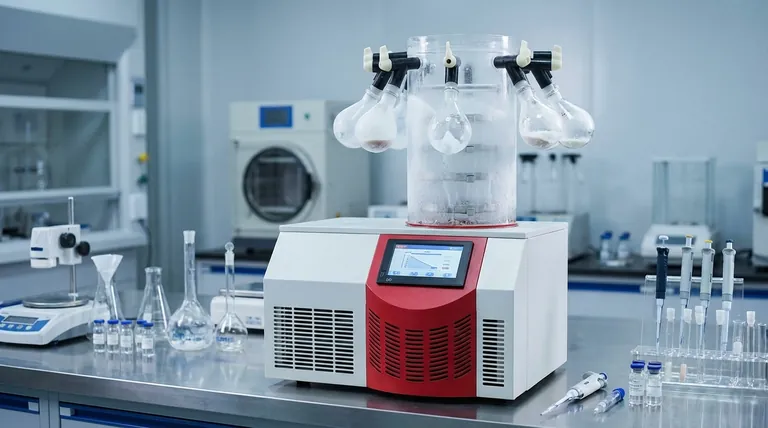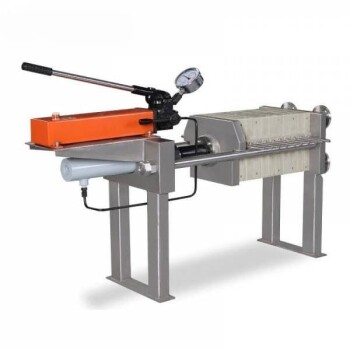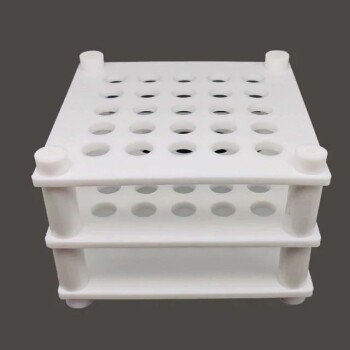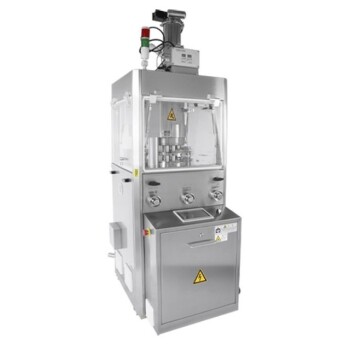In essence, a laboratory freeze dryer functions as a high-tech preservation tool for sensitive materials. It removes water by first freezing the sample and then applying a deep vacuum, which causes the frozen water (ice) to turn directly into vapor without ever becoming a liquid. This process, known as sublimation or lyophilization, is the key to preserving a sample's original biological and chemical structure.
Freeze-drying is not simply about removing water; it's about removing it in the gentlest way possible. By avoiding the damaging liquid phase and high heat, it protects the delicate molecular architecture of materials like vaccines, enzymes, and cell cultures, enabling long-term storage and stable transport.

The Principle of Sublimation: How It Preserves Integrity
The superiority of freeze-drying for sensitive materials is rooted in a single physical principle: sublimation. This process is far less destructive than conventional heat-based drying.
Bypassing the Damaging Liquid Phase
When a sample is dried with heat, water evaporates, leaving behind increasingly concentrated solutes. This changing chemical environment can denature proteins and damage cellular structures.
Freeze-drying completely bypasses this liquid phase. The sample remains frozen solid while the water molecules transition directly from ice to gas, leaving the delicate sample structure behind.
Maintaining Molecular Structure
During freezing, the ice forms a rigid scaffold that holds the other molecules in place. As the ice sublimates away, this scaffold is removed, but the original spatial arrangement of the key molecules (like proteins or antibodies) is largely maintained.
This preservation of structure is directly linked to the preservation of function. An enzyme that retains its shape is an enzyme that retains its activity.
Enabling Long-Term Stability
Most biological and chemical degradation reactions require water. By removing water to a very low residual level, freeze-drying effectively halts these processes.
This allows for products that are stable for years at room temperature, eliminating the need for a constant cold chain for storage and transport, which is a critical advantage in pharmaceuticals and diagnostics.
A Look Inside a Laboratory Freeze Dryer
A freeze dryer is a system of coordinated components, each playing a critical role in achieving and maintaining the conditions for sublimation.
The Cold Trap (Condenser)
The cold trap is the heart of the system. It is a refrigerated surface inside the dryer that is maintained at a much lower temperature (e.g., -50°C to -80°C) than the frozen sample.
As water vapor leaves the sample, it immediately migrates to and freezes onto the colder surface of the trap, effectively removing it from the system and driving the sublimation process forward.
The Vacuum System
A powerful vacuum pump lowers the atmospheric pressure inside the drying chamber. This low-pressure environment is the essential condition that allows ice to sublimate at low temperatures.
The vacuum ensures there are few air molecules to impede the flow of water vapor from the sample to the cold trap.
The Refrigeration System
The refrigeration unit serves two purposes. First, it may be used to freeze the samples before the drying process begins. Second, and more importantly, it is responsible for keeping the cold trap extremely cold throughout the drying cycle.
The Drying Chamber and Shelves
This is the main chamber that holds the samples, which can be in vials, flasks, or bulk trays. In more advanced systems, the shelves can be gently heated to provide the small amount of energy (the latent heat of sublimation) needed to speed up the process without melting the sample.
Understanding the Trade-offs and Limitations
While powerful, freeze-drying is not the solution for every drying task. Understanding its limitations is key to using it effectively.
It Is a Slow and Energy-Intensive Process
Sublimation is a slow physical process. A typical freeze-drying cycle can take anywhere from several hours to several days to complete, depending on the sample size and characteristics.
Furthermore, running the powerful refrigeration and vacuum systems is energy-intensive, making it a more costly process than simple oven drying.
High Initial Equipment Cost
Laboratory freeze dryers are complex, specialized instruments. Their initial purchase price is significantly higher than that of other laboratory drying equipment like ovens or rotary evaporators.
Sample Formulation Is Critical
Not all aqueous solutions can be successfully freeze-dried. Some materials can collapse during the process if they are not frozen correctly or if they lack the proper supporting structure.
Often, formulations must be optimized with cryoprotectants (like sugars or polymers) that help protect the active molecules during freezing and provide a stable, elegant structure to the final dried product.
Applying Freeze-Drying to Your Research
Choosing to use a freeze dryer depends entirely on your material's sensitivity and your final goal.
- If your primary focus is long-term stability of biologicals (e.g., vaccines, antibodies, enzymes): Freeze-drying is the gold standard for preserving biological activity and extending shelf life for storage and transport.
- If your primary focus is creating a porous solid that rehydrates instantly (e.g., instant coffee, pharmaceutical tablets): The process naturally creates a highly porous "cake" structure that allows water to penetrate and dissolve the product quickly.
- If your primary focus is simply removing water from a robust, non-sensitive chemical: A faster and more economical method like a vacuum oven or rotary evaporator is likely a better choice.
By understanding its principles, you can leverage freeze-drying not just to dry a sample, but to precisely engineer and preserve its most essential properties for future use.
Summary Table:
| Key Aspect | Description |
|---|---|
| Primary Function | Gently remove water via sublimation to preserve molecular structure. |
| Core Process | Lyophilization: Frozen water transitions directly from solid (ice) to gas (vapor). |
| Key Benefit | Enables long-term, room-temperature storage of sensitive materials (e.g., vaccines, enzymes). |
| Main Components | Drying chamber, cold trap (condenser), vacuum pump, refrigeration system. |
| Ideal For | Preserving biological activity, creating porous solids, stabilizing pharmaceuticals. |
Ready to enhance your lab's capabilities with precise freeze-drying? KINTEK specializes in providing high-quality laboratory freeze dryers and consumables designed to meet the exacting demands of pharmaceutical, biotech, and research laboratories. Our equipment ensures the gentle preservation of your most sensitive samples, from vaccines and enzymes to cell cultures.
Let us help you achieve superior sample stability and long-term storage. Contact our experts today to discuss your specific application and find the perfect freeze-drying solution for your lab.
Visual Guide

Related Products
- Benchtop Laboratory Freeze Dryer for Lab Use
- Benchtop Laboratory Vacuum Freeze Dryer
- Laboratory Sterilizer Lab Autoclave Pulse Vacuum Lifting Sterilizer
- Laboratory Sterilizer Lab Autoclave Vertical Pressure Steam Sterilizer for Liquid Crystal Display Automatic Type
- Laboratory Test Sieves and Sieving Machines
People Also Ask
- What are the main steps involved in the freeze-drying process? A Guide to the 3 Key Stages
- What role does freeze drying play in scientific research? Preserve Sample Integrity for Reliable Results
- What role do laboratory freeze dryers play in the food industry? Unlock Superior Food Preservation
- What are some common uses of freeze drying? Preserve Delicate Materials with Precision
- What types of liquid samples can be processed using a laboratory freeze dryer? Preserve Your Sensitive Materials



















